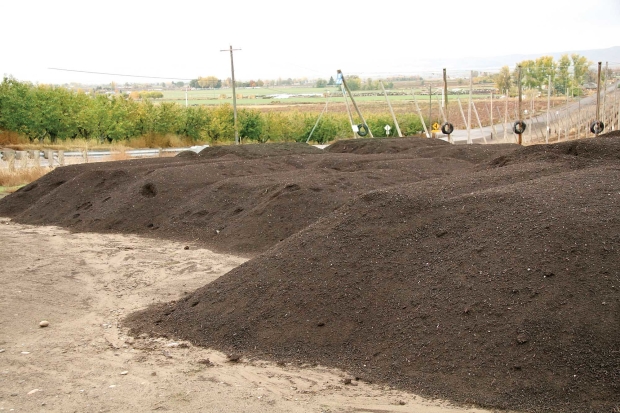
Finished compost has a fine texture, like good topsoil, and stability in long-term storage.
(Melissa Hansen/Good Fruit Grower)
Compost is revered as being one of the best things to add to your soil. But what does it do (or not do) and what is the best way to use it?
Making compost is decomposition en masse, says Dr. Lynne Carpenter-Boggs, soil scientist and researcher in Washington State University’s Department of Crop and Soil Sciences. It’s a biological process that transforms raw materials called feedstocks—the organic materials that decompose—into a stabilized, soil-like material called compost.
With the right blend of feedstocks, oxygen, water, and microbes, activity ramps up quickly. Heat and carbon dioxide are generated by the activities and respiration of the microorganisms.
Legally, compost must reach 131°F and stay at that temperature for three to 15 days, according to Carpenter-Boggs. Once it reaches 130°F, the compost environment changes significantly and there’s a change in the microorganisms that are active, she explained. “The 131°F is the magic number at which you know the compost has made the switch to the heat loving or thermophilic organisms. Many of the pathogenic organisms and weed seeds that we don’t want die at 130°F.”

Lynne Carpenter-Boggs
During the active phase of unturned composting systems, temperatures climb quickly to around 130°F and then decline over time. During the final or curing phase, another switch is made when the heat-loving organisms die off and beneficial organisms recolonize the material.
“Although we lose about half of the carbon that was in the initial material—which is why compost is so dark in color—most of the other nutrients are retained,” she said during a Washington State Grape Society meeting.
Because the finished compost reduces the mineralization rate of nitrogen, it is unlikely to burn crops or leach nitrogen below the root zone.
Compost retains—and tends to concentrate—any heavy metals that were in the original feedstocks. “So if it came in on the feedstocks, it doesn’t go anywhere in the composting process,” she said.
Carpenter-Boggs described finished compost as having complex humic acids, fine texture like good topsoil, no unpleasant odor or undecomposed material, and stability in long-term storage. “Humus is valuable because it encourages microbial activity and holds soil particles together, reduces erosion, and improves soil structure,” she said.
An optimum composting environment has the following attributes:
—Carbon-to-nitrogen ratio of 25-30:1
—Moisture content of 50 to 60 percent
—Oxygen greater than 5 percent
—pH 6.5 to 8
—Varied particle sizes (generally from 1/8 to 1/2 inch)
Compost approved for certified organic agriculture must be moderate to high quality and follow special National Organic Program regulations that include the following requirements:
—Feedstock mix has a carbon-to-nitrogen ratio of 15-60:1
—Temperature must reach 131°F at least three days
—All parts of pile must reach 131°F
—Compost must be tested for salmonella, Escherichia coli, and heavy metals
—No biosolids or prohibited materials used
If any of the requirements aren’t met, the material cannot be used as compost in organic agriculture. However, as long as no prohibited material is in the feedstock, it can be used as raw manure. Current rules require a 90-day interval between manure application and harvest of food crops that don’t touch the soil (such as tree fruits), or a 120-day interval for food crops that do touch the soil. These rules are being revised due to the new Food Safety and Modernization Act.
What’s in your compost?
Lab analysis is the only way to know what’s in your compost. There are no legal requirements that compost be tested for nutrients, only certain human pathogens and heavy metals, so you may have to test the material yourself.
No two composts are the same. The feedstock source and treatment can greatly impact the plant availability of nutrients, particularly nitrogen, says Kyle Bair of Soil Test Farm Consultants, Inc., in Moses Lake, Washington. For example, composted yard wastes will be vastly different from composted fish by-products or composted manures.
Bair recommends that growers learn the following about any finished compost they plan to use:
—pH (a typical range is 5.5 to 8.5)
—Moisture (15 to 40 percent range)
—Electrical conductivity or soluble salts
—Carbon-to-nitrogen ratio (if using as a fertilizer, should be less than 25:1, if as organic matter, should be 25-40:1)
—Plant-available nitrogen
—Other nutrients, such as phosphorus, potassium and sulfur
—Micronutrients, such as boron, zinc, copper, and manganese
Additionally, tests can be run on carbon dioxide evolution and ammonia (NH3), which are compost maturity indicators.
Nutrient analysis, carbon-to-nitrogen ratio, and pH determine quality and how to best use the compost.
“As a general rule, the closer in contact with growing plants, the higher quality and more stable you want the compost to be,” said Carpenter-Boggs. “A long curing phase is important because that’s when humic acids build and new microorganisms come back into the material.”
Lower quality or less mature composts still have value, but should be used as large-scale field amendments, top dressing, or mulch. “You’ll still get some benefits, like retaining soil moisture, protecting superficial roots, and building organic matter, but if it’s going to be in direct contact with roots, the compost needs to be really stable,” she said.
One of the last things to occur during the curing phase is conversion of ammonium to nitrate. A range of at least 400 parts per million of nitrate is a good indication of mature compost.
Slow release
When using compost as a fertilizer, be ready for a long wait. Nutrient release from compost happens in years, not weeks or months like inorganic fertilizers.
“Nutrient release happens very slowly and is usually around 10 to 15 percent of the amount applied in the first year,” said Carpenter-Boggs. Mineral fertilizers like greensand, rock phosphate, lime, azomite, or other rock powders can be added to the compost to increase mineral bioavailability. Compost can also be turned into compost tea for a faster way to extract the nutrient benefits.
In a best-case scenario with a high-nitrogen content compost of 5 percent and a 25 percent release rate, 200 pounds applied per acre will release about 2.5 pounds of nitrogen the first year, 1.9 pounds of nitrogen the second, and so on, she says.
“It takes three years to get half of the nitrogen out of the application and about nine years to get 90 percent of the nitrogen out of the application.”
Common application rates of compost are typically between 1.5 and 10 tons of dry compost per acre for annual application, but rates of 50 tons of dry compost per acre are not uncommon if applied sporadically.
Carpenter-Boggs said studies have shown that the peak of nutrient release from compost occurs in early to mid-summer, which is also the time of peak nutrient uptake by many plants.
The slow nutrient release can be good or bad, depending on your plant needs. Slow release is not necessarily bad, but has to be factored into your nutrient management, she said. •
ONLINE
How much nitrogen is in your compost? See application rates at soilplantlab.missouri.edu/soil/compost.aspx

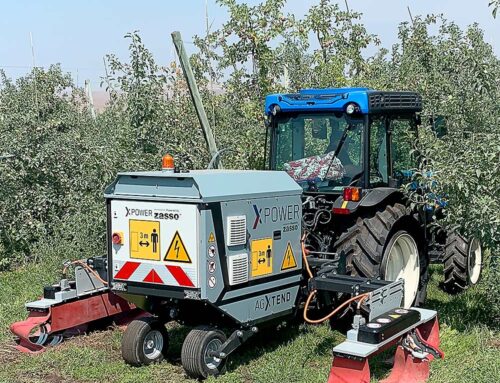
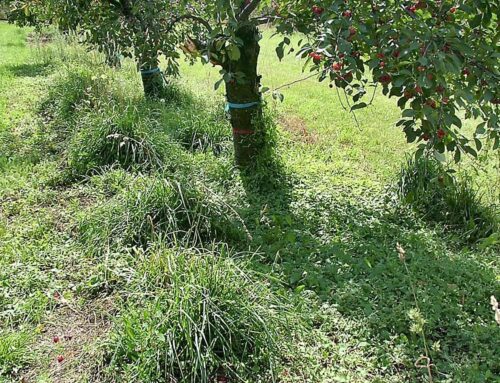
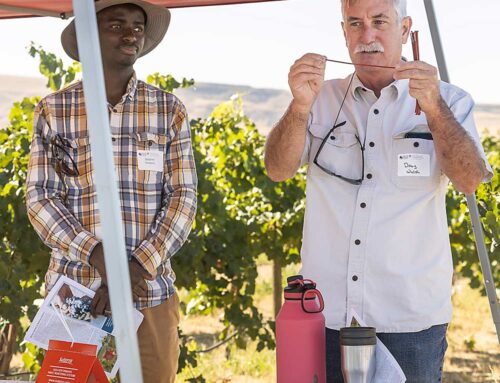
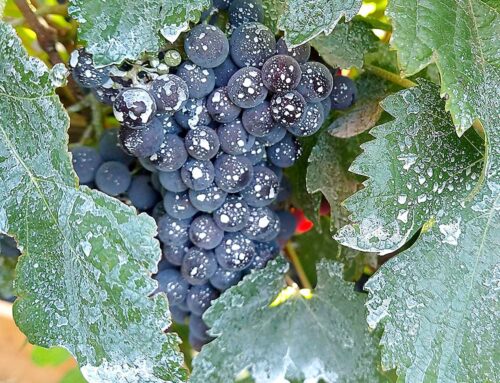
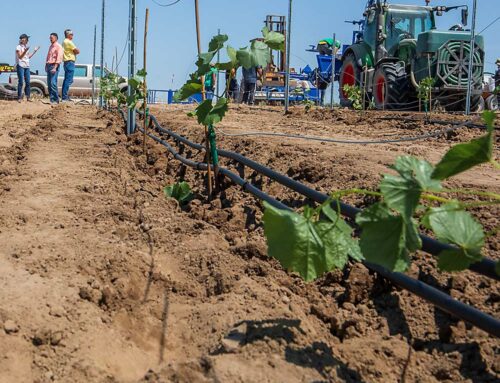
Leave A Comment